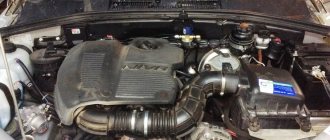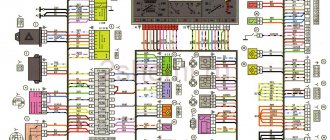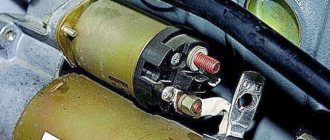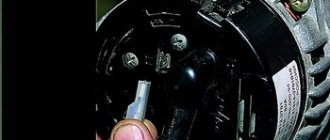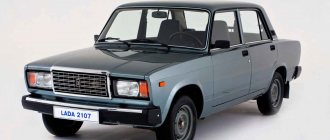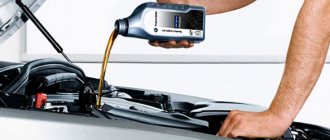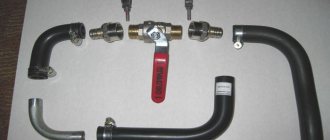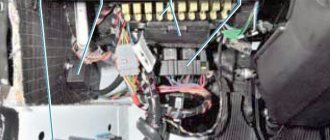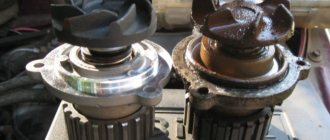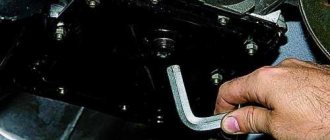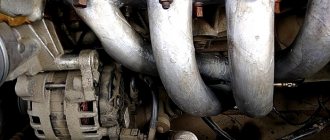Cars admin26.02.2020
*For vehicles with a fuel injection system with a catalytic converter and an oxygen concentration sensor. **Recommended application temperature range: 0W-30 below -35 o C...+25 o C 0W-40 below -35 o C...+30 o C 5W-30 -30 o C...+25 o C 5W-40 -30 o C...+35 o C 10W-30 -25 o C...+25 o C 10W-40 -25 o C...+35 o C 15W-40 -20 o C...+45 o C 20W-50 -15 o C ...above +45 o C ***Recommended application temperature range: 75W-80 -40 o C...+35 o C 75W-85 -40 o C...+35 o C 75W-90 -40 o C...+45 o C 80W-85 -26 o C...+35 o C 80W-90 -26 o C...+45 o C 85W-90 -12 o C...+45 o C and above
The text was scanned by Alex-Niva, processed by ALER, and supplemented by Katzyn.
Regarding the oil volume in the gearbox, the manual erroneously states 1.35 liters (in fact it should be 1.6 liters). It is recommended to fill 100-200 more grams (1.7. 1.8 l). To fill a larger volume of oil than the filler hole, the machine can be tilted to the right. Or you can simply “spit” excess oil into the filler hole, quickly plug it with your finger and screw on the plug.
Changing the oil in the transfer case Niva 21214
The Niva 21214 car is distinguished by its increased cross-country ability on roads. The car has an engine that has a volume of 1.7 liters, which complies with Euro-4 standards. The transmission system includes a transfer case with a crankcase ventilation system. All components on the VAZ 21214, just like on the VAZ 21213, are characterized by a long service life. It is important to take proper care of the automotive system and select high-quality oil for the Niva.
The Niva SUV (VAZ 2121), which has all-wheel drive and is equipped with a manual transmission, is capable of producing 75 horsepower.
Selecting gearbox oil
Which oil to choose? Transmission oils come in a wide range. You should pay attention to fuel that has the following viscosity: 75W-90, 85W-90. In particular, you can choose Lukoil 80W90 gear oil (GL5 class). When operating vehicles in winter, you should purchase 70W-90 oil, as it has a low viscosity. Semi-synthetic options are also suitable for refueling Niva 21213. It is better to carry out replacement at a specialized service center.
How much oil to fill? Approximately 0.8 liters of oil must be added to the Niva distributor. 1.6 liters of transmission fluid is poured into its high-speed box.
Before choosing a transmission fluid, you should always carefully study its composition.
The need to change transmission oil
To change the oil on a Niva, the car must be warmed up (to ensure good fluid fluidity). The machine is placed on an inspection hole; a special container should be placed under the drain hole into which the waste liquid will drain. To open the drain and fill plug, you should use a hexagon. Also, as an additional tool, you will need a special syringe, which is used to fill the transfer case with fuel.
Changing the oil in the transfer case (Niva 21214 / 21213). Main stages:
- The drain plug is unscrewed.
- The remaining oil is poured into the container.
- Any contamination on the plug must be eliminated.
- The drain plug is screwed in.
- The top plug is unscrewed to fill in new oil using a syringe.
- The plug is screwed in.
The peculiarity of the gearbox is that it has a built-in magnet. Its function is to attract small metal debris that may be present in the fuel.
When replacing fuel, the crankcase must be flushed. This procedure helps to extend the operational life of the box. Flushing is required if the drained oil is heavily contaminated.
The frequency of changing fuel for the transmission is affected by the mileage of the Niva 21214 (21213) and the conditions under which it is used. When making frequent off-road trips, the need to change the oil for the transfer case and gearbox may arise up to 50,000 km.
The need to add a new lubricant to the box can be indicated by the fact that the gearbox began to overheat and characteristic noises appeared on its side during movement.
Custom Options
Technical characteristics of the car Lada (VAZ) 21703 (priora) (2007(2013)). Lada 217030 technical specifications. 217030 Lada Priora
Technical characteristics of the Niva 2131 include operational features, engine properties and fuel and speed parameters.
Basic data on the model under consideration are presented in the table:
| Index | Definition |
| Body type | all-metal, monocoque, 5-door station wagon |
| Body class | SUV |
| Layout diagram | all-wheel drive, longitudinal engine |
| Number of places, people | 5, with the rear seat backs folded – 2 |
| Trunk volume, l | 420, with seats folded – 780 |
| Transmission type | 5MT |
| Wheelbase, mm | 2700 |
| Front/rear wheel track, mm | 1440/1420 |
| Front/rear brakes | Disc/drum |
The vehicle ground clearance (clearance) with a static tire radius of 314 mm (185/75R16) is:
- to the front suspension cross member - at least 221 mm,
- to the rear axle beam – 213 mm.
Suspension:
- front – independent, on wishbones, spring, with hydraulic telescopic shock absorbers and anti-roll bar;
- rear - dependent, lever, spring, with hydraulic telescopic shock absorbers.
For a 4x4 vehicle, the wheels account for 100% of the weight. That is why an all-wheel drive vehicle has a traction force that is approximately 2 times greater than a vehicle with a 4x2 wheel arrangement. Thanks to the front wheels installed at certain angles relative to the body parts and suspension, this car has good stability and controllability. A special feature of the 2131 model is that it prohibits towing a trailer. The motor parameters have the following characteristics:
- Type of power unit - 4-cylinder, in-line, 4-stroke.
- Engine displacement, l – 1.69.
- Power, l. With. – 83.
- Cylinder diameter and piston stroke, mm – 82x80.
- Compression ratio – 9.3.
- Power/ignition system – distributed fuel injection.
Fuel and speed characteristics of the Lada Niva 2131:
- Filling volume of the fuel tank, l – 65.
- Fuel type – gasoline (AI-95).
- Maximum speed, km/h – 137.
- Acceleration time to 100 km/h, sec. – 19.0.
Fuel consumption:
- with a combined cycle, l/100 km – 11.2;
- in city driving – l/100 km – 12.1;
- in suburban driving – l/100 km – 8.3.
In terms of technical characteristics, the Lada Niva 2131 is not inferior to its more expensive analogues.
Changing the oil in the Niva 21213, 2121 gearbox
According to the recommendations of the VAZ manufacturer, the oil level should be checked after every forty to sixty thousand kilometers, but practice shows that it is better to do this at least twice as often. If, during inspection, you find that the oil is dirty and smells of burning, this means that it needs to be changed immediately. This procedure is easy to carry out yourself. Changing the oil in Niva 21213 is done in exactly the same way as in 2121.
Changing the oil in the gearbox.
The entire operation must be carried out in the inspection hole, and before the operation you need to drive eight to ten km so that the oil warms up.
If you are changing the oil for the first time, the first thing you need to do is find the filler neck. It is located on the left side and may not be immediately noticeable due to the gimbal. Do not confuse it with the technological plug, which is located on the right.
Having found the neck, take a 12mm hex and unscrew the drain plug. Place a container near the neck and let the oil drain. Next, clean the plug magnet from dirt and metal particles and screw the plug back on.
Now take the 17 key and unscrew the filler plug. Then, using a special syringe, fill the oil to the bottom edge of the hole and tighten the plug. All.
By the way, sometimes it happens that the box becomes clogged with metal shavings or the seals begin to leak. In such cases, you just need to add oil.
| Refillable system | Volume, l |
| Fuel tank (including reserve) | 42 (65*) |
| Engine cooling system (including interior heating system) | 10,7 |
| Engine lubrication system (including oil filter) | 3,75 |
| Gearbox housing | 1,6 |
| Rear axle housing | 1,3 |
| Steering gear housing | 0,18 |
| Transfer case housing | 0,79 |
| Front axle housing | 1,15 |
| Hydraulic clutch system | 0,2 |
| Hydraulic brake system | 0,535 |
| Windshield and headlight washer reservoir | 2,8 |
| Rear window washer reservoir | 2,0 |
| Power steering reservoir | 1,7 |
* For VAZ-2131 cars and its modifications.
Refueling or lubrication point
Quantity, l
Name of materials
Motor gasoline with octane number 91–93, 95*
Engine cooling system including interior heating system
Coolant with a freezing point no higher than –40°C
Engine lubrication system, including oil filter, at ambient temperature:
Motor oils (with API quality level: SG, SH, SJ)
Gearbox housing
Gear oils with quality level according to API GL-5 and viscosity 75W-90
Transfer case housing
Front axle housing
Rear axle housing
Steering gear housing
Gear oil 75W-90
Hydraulic clutch release system Hydraulic brake system
Windshield washer reservoir Tailgate washer reservoir
A mixture of water and windshield washer fluid
Starter drive drive ring
Litol-24 lubricant or imported analogues
Front wheel bearings
Litol-24 lubricant or imported analogues
Cardan joint cross bearings
Reservoir for windshield and brake fluid.
Page 62
Another filling capacity of the Chevrolet Niva is two glass washer reservoirs, the capacity of which is five and two liters.
This model has two independent braking systems. The working one has a hydraulic drive, the parking one has a mechanical drive. The contours are separated from each other.
The hydraulic drive includes a special tank made for brake fluid.
- DOT-4 brake fluid is suitable for half-liter hydraulic brakes. The product has improved characteristics and has a boiling point of over 235 degrees. Well suited for regions with low ambient temperatures.
- SAEJ1703, FMSS116 are used for the entire hydraulic system and clutch release (0.15 l). The synthetic product provides good lubrication and reduces oxidation at high temperatures.
- The tank lid hatch hinges, door and hood locks require VTV-1 and FIOL-1 greases. Hinges of steering rods and cardan shafts - ShRB-4, Litin 2, Esma.
- The air conditioner also has two tanks. One of them is for oil (0.22 l), the other is for refrigerant (0.650 kg).
Chevrolet Niva reservoirs for refilling liquids and lubricants are quite reliable and convenient when you need to make a replacement.
Various tags and sensors make it possible to carry out control almost immediately, which allows you to avoid an emergency situation.
Motor oils
| Oil brand | SAE viscosity grade | Group | Manufacturer | Regulatory document | |
| AAI | AP1 | ||||
| LUKOIL LUX | 5W-30, 5W-40 10W-40,15W-40 | B5/D3 | SJ/CF | LLC "Lukoil-Permnefteorg-sintez", Perm | STO 00044434-003 |
| LUKOIL LUX | 0W-40, 5W-20, 5W-30, 5W-50, 10W-30 | B5/D3 | SL/CF | LLC "Lukoil-Permnefteorg-sintez", Perm | STO 00044434-003 |
| TNK SUPER | 5W-30, 5W-40 10W-40 | B5/D3 | SJ/SL/CF | TNK Lubricants LLC, Ryazan | TU 0253-008-44918199 |
| TNK MAGNUM | 5W-30, 5W-40 10W-40,15W-40 | B5/D3 | SJ/SL/CF | TNK Lubricants LLC, Ryazan | TU 0253-025-44918199 |
| ROSNEFT MAXIMUM | 5W-40, 10W-40 | B5/D3 | SL/CF | OJSC "Novokuibyshevsk Oil and Additives Plant", Novokuibyshevsk | TU 0253-063-48120848 |
| ROSNEFT OPTIMUM | 10W-30, 10W-40 15W-40 | B5/D3 | SJ/CF | OJSC "Novokuibyshevsk Oil and Additives Plant", Novokuibyshevsk | TU 0253-062-48120848 |
| ROSNEFT MAXIMUM | 5W-40, 10W-40 | B5/D3 | SL/CF | OJSC "Angarsk Petrochemical Company", Angarsk | TU 0253-391-05742746 |
| ROSNEFT OPTIMUM | 10W-30, 10W-40 15W-40 | B5/D3 | SJ/CF | OJSC "Angarsk Petrochemical Company", Angarsk | TU 0253-389-05742746 |
| ROSNEFT PREMIUM | 0W-40, 5W-40 5W-40 | B5/D3 | SJ/CF SL/CF SM/CF | OJSC "Angarsk Petrochemical Company", Angarsk | TU 0253-390-05742746 |
Continuation of the table. 2
| Oil brand | SAE viscosity grade | Group | Manufacturer | Regulatory document | |
| AAI | API | ||||
| EXTRA 1 EXTRA 5 EXTRA 7 | 5W-30 15W-40 20W-50 | B5/D3 | SJ/CF | OJSC "Omsk Oil Refinery", Omsk | TU 38.301-19-137 |
| EXTRA | 5W-30, 10W-40, 15W-40 | B5/D3 | SL/CF | OJSC "Omsk Oil Refinery", Omsk | TU 38.301-19-137 |
| ESSO ULTRA | 10W-40 | B5/D3 | SJ/SL/CF | Exxon-Mobil, Germany | |
| GTTURBO SM | 10W-40 | B5 | S.M. | Hanval INC, Korea | |
| LIQUI MOLY OPTIMAL | 10W-40 | B5/D3 | SL/CF | Liqui Moly GmbH, Germany | |
| MOBIL 1 MOBIL SYNT S MOBIL SUPER S | 0W-40, 5W-50 5W-40 10W-40 | B5/D3 | SJ/SL SM/CF SJ/SL/CF | Exxon-Mobil, Germany | |
| MOBIL 1 ESP FORMULA | 5W-30 | B6/D3 | SJ/SL SM/CF | ||
| RAVENOL HPS RAVENOL VSI RAVENOL LLO RAVENOL TSI RAVENOL Turbo-C HD-C | 5W-30 5W-40 10W-40 10W-40 15W-40 | B5/D3 | SL/CF SL/CF SL/CF SL/CF SJ/CF | Ravensberger Schmirstoffvertrieb GmbH, Germany | |
| SHELL HELIX: PLUS PLUS EXTRA ULTRA | 10W-40 5W-40 5W-40 | B5/D3 | SL/CF | SHELL EAST EUROPE Co, UK, Finland | |
| ZIC A PLUS | 5W-30, 10W-30, 10W-40 | B5 | SL | SK CORPORATION, Korea | |
Note. The oil change period is in accordance with the vehicle service book.
RECOMMENDED TEMPERATURE RANGES FOR APPLICATION OF MOTOR OILS
| Minimum engine cold start temperature, 0C | Viscosity grade according to SAE J 300 | Maximum ambient temperature, 0C |
| below -35 | 0W-30 | 25 |
| below -35 | 0W-40 | 30 |
| -30 | 5W-30 | 25 |
| -30 | 5W-40 | 35 |
| -25 | 10W-30 | 25 |
| -25 | 10W-40 | 35 |
| -20 | 15W-40 | 45 |
| -15 | 20W-40 | 45 |
For Russia
1st generation, 04.1977 - 11.2019, Jeep/SUV 3 doors.
| Equipment | Release period | Price | Engine make | Body brand |
| 1.7 l, 83 hp, Gasoline, manual transmission, all-wheel drive (4WD) | ||||
| 1.7 MT Elbrus Edition | 12.2015 — 03.2016 | 472,700 rub. | VAZ-21214 | 21214 |
| 1.7 MT Lux | 12.2015 — 03.2016 | 472200 rub. | VAZ-21214 | 21214 |
| 1.7 MT Lux | 12.2015 — 03.2016 | 477200 rub. | VAZ-21214 | 21214 |
| 1.7 MT Standard | 12.2015 — 03.2016 | 462,700 rub. | VAZ-21214 | 21214 |
| 1.7 MT Elbrus Edition | 12.2015 — 03.2016 | 472,700 rub. | VAZ-21214 | 21214 |
| 1.7 MT Lux | 01.2016 — 03.2016 | 490200 rub. | VAZ-21214 | 21214 |
| 1.7 MT Standard | 03.2016 — 09.2016 | 465,700 rub. | VAZ-21214 | 21214 |
| 1.7 MT Lux | 03.2016 — 09.2016 | 475200 rub. | VAZ-21214 | 21214 |
| 1.7 MT Elbrus Edition | 03.2016 — 09.2016 | 478200 rub. | VAZ-21214 | 21214 |
| 1.7 MT Elbrus Edition | 03.2016 — 09.2016 | 478200 rub. | VAZ-21214 | 21214 |
| 1.7 MT Lux | 03.2016 — 09.2016 | 480200 rub. | VAZ-21214 | 21214 |
| 1.7 MT Lux | 03.2016 — 09.2016 | 493200 rub. | VAZ-21214 | 21214 |
| 1.7 MT Lux | 10.2016 — 04.2018 | 499900 rub. | VAZ-21214 | 21214 |
| 1.7 MT Elbrus Edition | 10.2016 — 12.2016 | 478200 rub. | VAZ-21214 | 21214 |
| 1.7 MT Elbrus Edition | 10.2016 — 12.2017 | 492900 rub. | VAZ-21214 | 21214 |
| 1.7 MT Lux | 10.2016 — 12.2016 | 480200 rub. | VAZ-21214 | 21214 |
| 1.7 MT Lux Air Conditioner | 10.2016 — 04.2018 | 521900 rub. | VAZ-21214 | 21214 |
| 1.7 MT Standard | 10.2016 — 04.2018 | 483900 rub. | VAZ-21214 | 21214 |
| 1.7MT Orange Edition | 11.2016 — 04.2018 | 540,000 rub. | VAZ-21214 | 21214 |
| 1.7MT Black Edition | 11.2016 — 08.2018 | 550,000 rub. | VAZ-21214 | 21214 |
| 1.7 MT Standard | 12.2016 — 12.2016 | 470,700 rub. | VAZ-21214 | 21214 |
| 1.7 MT Lux Air Conditioner | 12.2016 — 12.2016 | 498200 rub. | VAZ-21214 | 21214 |
Flushing fluids for the engine lubrication system
Liquid brand
Manufacturer
Regulatory document
OJSC Lukoil-Nizhegorodnefteorgsintez, Kstovo, LLC Lukoil-Permnefteorgsintez, Perm
OJSC Novo-Ufa Oil Refinery, Ufa
OAO Angarsk Petrochemical Company, Angarsk
MP SYNTHETIC MP CLASSIC
OJSC "Omsk Oil Refinery", Omsk
Note. Flushing fluids are used during maintenance in accordance with the service book when replacing the working engine oil with fresh one.
Specifications
The five-door version of the 2022 Lada 4×4 Niva has 5 seats, and the three-door version can comfortably accommodate no more than 4 passengers. In addition, the “three-door” is 20 mm lower than its five-door “brother”, whose ground clearance is 220 mm. It is also not surprising that the weight of SUVs differs by 140 kg - the three-door version weighs 1,285 kg, while the weight of the five-door version is 1,425 kg.
The 50 cm difference in wheelbase also played a role in the dimensions of the cars. We will display their main indicators in a list. The standard three-door Lada 4×4 Niva has the following dimensions:
- wheelbase length - 2,200 mm;
- body length - 3,740 mm;
- width -1,680 mm;
- height - 1,640 mm.
The five-door model has the following dimensions:
- wheelbase length - 2,700 mm;
- body length - 4,240 mm;
- width - 1,680 mm;
- height - 1,640 mm.
As you can see, the width and height of both versions remain unchanged, while at the same time the weight, body length and wheelbase vary. Otherwise the cars are completely similar. They are based on a front fully independent double wishbone suspension. A dependent spring structure is installed at the rear. In addition, there are two anti-roll bars. The braking system is based on front disc and rear drum mechanisms. And for easier maneuvers on the road, a special power steering is installed.
An in-line 4-cylinder naturally aspirated engine with a power of 83 hp is installed in the engine compartment. and 129 Nm of torque. It is paired with a 5-speed manual gearbox, which redirects power to the permanent all-wheel drive system. According to the automaker's recommendations, AI-95 gasoline is required for normal operation of the power unit. The SUV tank holds 42 liters in the three-door version and 65 liters in the five-door version. It is worth noting that the main advantage of the latter is the larger volume of the luggage compartment - 420 liters in the standard position versus 265 liters for the three-door.
Fuel consumption (city) 12.1 l Fuel consumption (highway) 8.3 l Fuel consumption (mixed) 9.9 l Fuel type Gasoline Acceleration 0-100 km/h 17 s Top speed 142 km/h
Power 83 hp at 5000 rpm. Torque 129 Nm at 4000 rpm. Engine location Front, longitudinal Engine capacity 1690 cm 3 Number of cylinders 4 Cylinder position In-line Fuel system Direct injection Turbine no
Transmission
The Niva 4x4 transmission system has the following filling volumes:
- transfer case - 0.79 l;
- gearbox - 1.6 l;
- rear axle - gearbox - 1.3 l;
- front axle - crankcase - 1.15 l;
- steering column - crankcase - 0.18-0.2 l.
As with the operation of a power unit, under different temperature conditions, transmission units and assemblies are filled with oils of different viscosities, which is reflected in the table:
| Lower limit of ambient temperature, °C | -15 | -25 | -25 | -30 | -40 |
| Upper limit of ambient temperature, °C | +45 | +45 | +35 | +45 | +35 |
| SAE lubricant viscosity grade | 85W-90 | 80W-90 | 80W-85 | 75W-90 | 75W-80 As stated in the operating instructions, transmission lubricants must be changed once every 30 thousand km. mileage At the same time, replacement is not provided for in the steering mechanism housing, only an addition through the top plug. The “native” oil for Zhiguli transmission units is considered to be TAD17I. Transmission oils have good penetrating ability. Therefore, poorly clamped plugs and worn gaskets of units begin to gradually leak lubricant. In such situations, it is allowed to add oil of the same viscosity class and, preferably, the same manufacturer. If you do not top up during a leak, the lubricant level in the unit will decrease, which will lead to accelerated wear of expensive mechanisms. |
Basic car configurations
The factory supplies 3 main modifications of the car. They have indexes 1.7, 1.7i and 1.8. All models have the same appearance, are equipped with a five-speed gearbox, and by the designations you can understand what type of engine is installed on the car.
The VAZ 2131 1.7i variety is distinguished by the fact that it has an engine with a modified fuel injection system. An injector is installed on it, which ensures uniform enrichment of the fuel mixture and its faster entry into the cylinder. For normal operation, it is recommended to use AI-95 fuel.
Niva 2131 1.8 differs from previous versions in that it is equipped with an engine with a volume increased to 1.77 liters, which allows it to develop the greatest power and speed. The piston stroke increased to 85 millimeters and a large combustion chamber made it possible to reduce the compression ratio to 8.4. The changes made it possible to achieve an increase in power to 82 hp.
Despite all the differences in the engines, they have the same fuel consumption. In the urban cycle it reaches 12.2 liters per 100 kilometers. This is quite a large figure, so a tank with a volume of 65 liters is installed on the car.
AUTOMOTIVE GASOLINES
1. To ensure engine starting and vehicle operation at low negative ambient temperatures, it is necessary to use gasoline of the appropriate volatility classes depending on the climatic region. Requirements for volatility classes and seasonal use of gasoline for various regions of the Russian Federation are set out in the relevant standards for fuels for internal combustion engines.
2. The use of gasoline with organometallic antiknock agents based on lead, iron, manganese and other metals is not allowed.
3. The use of multifunctional additives is allowed to protect fuel supply and engine parts from corrosion, deposits and carbon deposits. Such additives must be added to commercial gasoline by the gasoline manufacturer.
Greases
| Lubricant brand | Manufacturer | Regulatory document |
| Vaseline technical VTV-1 | JSC "Rikos", Rostov-on-Don | TU 38.301-40-21 |
| Vaseline technical ONMZ VTV-1 | JSC "Neftemaslozavod", Orenburg | TU 0255-195-05767887 |
| Lubricant AZMOL GRAPHITOL | OJSC "Azmol", Berdyansk | TU U 23.2-00152365-178 |
| LIMOL lubricant | OJSC "Azmol", Berdyansk | TU 38.301-48-54 |
| LITA grease | OJSC "Azmol", Berdyansk | TU 38.101-1308 |
| LITOL-24 lubricant | OJSC "Azmol", Berdyansk | GOST 21150 |
| Grease AZMOL LSC-15 | OJSC "Azmol", Berdyansk | TU U 23.2-00152365-180 |
| UNIROL-1 grease | JSC "Rikos", Rostov-on-Don | TU 38.301-40-23 |
| Grease UNIOL-2M/1 | OJSC "Azmol", Berdyansk | TU 38.5901243 |
| Grease AZMOL FIOL-1 | OJSC "Azmol", Berdyansk | TU U 23.2-00152365-173 |
| Grease AZMOL ShRB-4 | OJSC "Azmol", Berdyansk | TU U 23.2-00152365-172 |
| Lubricant AZMOL SHRUS-4 | OJSC "Azmol", Berdyansk | TU U 23.2-00152365-182 |
| CV joint grease-4M | OJSC "Perm Plant of Lubricants and Coolants", Perm | TU 38.401-58-128 |
| Ortol Sh lubricant | JSC "Neftemaslozavod", Orenburg | TU 0254-001-05767887 |
| Grease CIATIM-201 | OJSC "Azmol", Berdyansk, OJSC "Rikos", Rostov-on-Don, LLC NPF "RUSMA", St. Petersburg, OJSC "Neftemaslozavod", Orenburg | GOST 6267 |
| Grease CIATIM-221 | OJSC "Azmol", Berdyansk, OJSC "Rikos", Rostov-on-Don, LLC NPF "RUSMA", St. Petersburg | GOST 9433 |
Continuation of the table. 9
| Lubricant brand | Manufacturer | Regulatory document |
| Solid lubricant Molybdol M3 | CJSC "Technology", St. Petersburg | TU 301-02-63 |
| Lubricating graphite “P” | OJSC "Azmol", Berdyansk | GOST 8295 |
| Ditor lubricant | JSC "Rikos", Rostov-on-Don | TU 0254-007-05766706 |
| CASTROL S-058 grease | , Germany | TTM 1.97.733 |
| MOLYKOTE X-106 grease | , USA | TTM 1.97.0115 |
| Renolit JP 1619 grease | , Germany | TTM 1.97.0800 |
| Lubricant Lucas PFG-111 | , Germany | TTM 1.97.0733 |
Power unit
The engine installed on the modern model of the Niva 21213 (214) car was inherited from its Soviet progenitor - the VAZ 2121, and in terms of fluid volumes they are almost identical:
- Liquid cooling system. Filled with antifreeze in an amount of 10.7 liters with a freezing point not higher than -40 ° C. The capacity of the interior heating radiator is also included in this volume.
- Crankcase. Motor oils are poured here, the brand of which depends on the operating conditions. Capacity: 3.75 liters, including oil filter filling.
The viscosity of the oil poured into the Niva engine must correspond to the outdoor temperature at which the car is operated. Possible modes and suitable oil brands are shown in the table:
Dimensions, ground clearance
What are the dimensions of the 5-door Niva? The length of the old and new Niva is different. So, in the first case, this parameter is 4.22 meters, in the second – 4.14. The reason for this was the new bumpers. Otherwise, the dimensions of the body do not differ, since its architecture has not changed at all. So, the width of the car is 1.69 meters, height – 1.64. The curb weight of the extended Niva is 1.35 tons. At the same time, the car can take on board up to 500 kilograms of cargo (luggage plus passengers).
As for ground clearance, its value is 20.5 centimeters on standard 16-inch wheels. As owner reviews note, the 5-door Niva, although longer than the three-door, behaves very confidently in mud and swamps. In terms of cross-country ability, this car deserves the highest praise.
VAZ 21213 | Refill tanks
2.3.3. Refill tanks
| GENERAL INFORMATION |
| Year | Model | Series name | Cylinder displacement (cm3) | Oil volume in 5-gearbox transmission | Engine oil volume (including filter) |
| 1984–1986 | troper/ bighorn | 4zd1 | 2250 | 4,6 | 4,4 |
| 1984–1986 | troper/ bighorn | S223 T | 2238 | 4,6 | 6,0 |
| 1987 | troper/ bighorn | 4ze1 | 2559 | 3,1 | 4,4 |
| 1987 | troper/ bighorn | S223 T | 2238 | 4,6 | 6,0 |
| 1987 | troper/ bighorn | 4jb1-T | 2772 | – | – |
| 1988 | troper/ bighorn | 4ze1 | 2559 | 3,1 | 4,4 |
| 1988 | troper/ bighorn | 4jb1-T | 2772 | – | – |
| 1989 | troper/ bighorn | 4ze1 | 2559 | 3,1 | 5,2 |
| 1989 | troper/ bighorn | v6, 2.8 l | 2800 | 3,1 | 4,5 |
| 1989 | amigo/ mu | 4zd1 | 2250 | 1,6 | 4,2 |
| 1989 | amigo/ mu | 4ze1 | 2559 | 3,1 | 5,2 |
| 1990 | troper/ bighorn | 4ze1 | 2559 | 3,1 | 5,2 |
| 1991 | troper/ bighorn | v6, 2.8 l | 2800 | 3,1 | 4,5 |
| 1991 | amigo/ mu | 4zd1 | 2250 | 1,6 | 4,2 |
| 1991 | amigo/ mu | 4ze1 | 2559 | 3,1 | 5,2 |
| 1991 | rodeo | 4ze1 | 2559 | 3,1 | 5,8 |
| 1991 | rodeo | v6 | 3100 | 2,4 | 4,3 |
| 1992 | amigo/ mu | 4zd1 | 2250 | 1,6 | 4,2 |
| 1992 | amigo/ mu | 4ze1 | 2559 | 3,1 | 5,2 |
| 1992 | rodeo | 4ze1 | 2559 | 3,1 | 5,8 |
| 1992 | rodeo | v6 | 3100 | 2,4 | 4,3 |
| 1993 | amigo/ mu | 4zd1 | 2250 | 1,6 | 4,2 |
| 1993 | amigo/ mu | 4ze1 | 2559 | 3,1 | 5,2 |
| 1993 | rodeo | 4ze1 | 2559 | 3,1 | 5,8 |
| 1993 | rodeo | v6 | 3100 | 2,4 | 4,3 |
| 1994 | amigo/ mu | 4zd1 | 2250 | 1,6 | 4,2 |
| 1994 | amigo/ mu/ jazz | 4ze1 | 2559 | 3,1 | 5,2 |
| 1994 | rodeo/ passport | 4ze1 | 2559 | 3,1 | 5,8 |
| 1994 | rodeo | v6 | 3100 | 2,4 | 4,3 |
| 1995 | amigo/ mu | 4zd1 | 2250 | 1,6 | 4,2 |
| 1995 | amigo/ mu/ jazz | 4ze1 | 2559 | 3,1 | 5,2 |
| 1995 | rodeo/ passport | 4ze1 | 2559 | 3,1 | 5,8 |
| 1995 | rodeo | v6 | 3100 | 2,4 | 4,3 |
| Year | Model | Automatic transmission | Rear axle gearbox | Fuel tank | Cooling system |
| 1984–1986 | troper/ bighorn | – | 1,6 | 82 | 9,2 |
| 1984–1986 | troper/ bighorn | – | 1,6 | 82 | 11,4 |
| 1987 | troper/ bighorn | 6,0 | 1,0 | 82 | 9,2 |
| 1987 | troper/ bighorn | – | 1,6 | 82 | 11,4 |
| 1987 | troper/ bighorn | – | – | – | – |
| 1988 | troper/ bighorn | – | 1,0 | 82 | 9,2 |
| 1988 | troper/ bighorn | – | – | – | – |
| 1989 | troper/ bighorn | 6,0 | 1,9 | 83 | 9,2 |
| 1989 | troper/ bighorn | 4,6 | 1,9 | 83 | 11,8 |
| 1989 | amigo/ mu | – | 1,6 | 83 | 10,8 |
| 1989 | amigo/ mu | 7,3 | 1,9 | 83 | 10,8 |
| 1990 | troper/ bighorn | 6,0 | 1,9 | 83 | 9,2 |
| 1991 | troper/ bighorn | 4,6 | 1,9 | 83 | 11,8 |
| 1991 | amigo/ mu | – | 1,6 | 83 | 10,8 |
| 1991 | amigo/ mu | 7,3 | 1,9 | 83 | 10,8 |
| 1991 | rodeo | 9,5 | 2,0 | 83 | 10,8 |
| 1991 | rodeo | 9,5 | 2,0 | 83 | 13,0 |
| 1992 | amigo/ mu | – | 1,6 | 83 | 10,8 |
| 1992 | amigo/ mu | 7,3 | 1,9 | 83 | 10,8 |
| 1992 | rodeo | 9,5 | 2,0 | 83 | 10,8 |
| 1992 | rodeo | 9,5 | 2,0 | 83 | 13,0 |
| 1993 | amigo/ mu | – | 1,6 | 83 | 10,8 |
| 1993 | amigo/ mu | 7,3 | 1,9 | 83 | 10,8 |
| 1993 | rodeo | 9,5 | 2,0 | 83 | 10,8 |
| 1993 | rodeo | 9,5 | 2,0 | 83 | 13,0 |
| 1994 | amigo/ mu | – | 1,6 | 83 | 10,8 |
| 1994 | amigo/ mu/ jazz | 7,3 | 1,9 | 83 | 10,8 |
| 1994 | rodeo/ passport | 9,5 | 2,0 | 83 | 10,8 |
| 1994 | rodeo | 9,5 | 2,0 | 83 | 13,0 |
| 1995 | amigo/ mu | – | 1,6 | 83 | 10,8 |
| 1995 | amigo/ mu/ jazz | 7,3 | 1,9 | 83 | 10,8 |
| 1995 | rodeo/ passport | 9,5 | 2,0 | 83 | 10,8 |
| 1995 | rodeo | 9,5 | 2,0 | 83 | 13,0 |
History of the machine
Lada 4×4 2131 Niva 2006
It all started back in 1970, when Chairman of the Council of Ministers of the USSR Alexei Kosygin, as part of the program “blurring the line between city and countryside,” set the teams of VAZ, AZLK and Izhmash the task of creating a comfortable SUV for residents of rural areas.
The first experimental VAZ-E2121 saw the light of day in 1971. Moreover, his appearance was very far from what we have become accustomed to for forty years. In fact, it was a chassis with a simple tail, on which the concept of a new car was developed - the SUV did not have a frame, which at that time was considered an unheard-of design audacity. Initially, the car was planned to be equipped with a powerful diesel engine, final drives, rear torsion bar suspension and even a tire pressure regulation system, but later they decided to create a simpler version with a high degree of unification with the models already produced by AvtoVAZ, which was economically justified. This prototype allowed the design bureau under the leadership of Peter Prusov to significantly reduce the time needed to create the car.
The VAZ-2121 appeared in a form close to the serial one in 1972. The artist Valery Semushkin worked on the design of the new car. The car, according to the designer, was supposed to suit residents of both cities and villages.
In 1974, the car was put up for state tests and in the same year received its own name “Niva”, which was patented.
In addition to sales at home, Niva was actively promoted in foreign markets. Over forty years, more than 500 thousand SUVs were sent abroad. This unpretentious, but at the same time quite comfortable SUV has attracted buyers in more than 100 countries around the world. Importers actively re-equipped the car, making it into pickup trucks, convertibles, and styling it according to fashion. In addition, assembly of the model was established in Brazil, Greece, Canada, Panama, Chile, and Ecuador.
In 1978, the VAZ-2121 was awarded a gold medal and recognized as the best car of its class at the international exhibition in Brno. “Niva” has a lot of records.
So, in 1998, Niva climbed Mount Everest under its own power, to a height of 5200 meters, in the same year, being dropped by parachute, it ended up in the Arctic and reached the North Pole under its own power, and the next year climbed to the Himalayas to a height of 7260 meters. She also visited Fuji. The reliability of the car is also evidenced by the fact that the production car was able to operate without serious breakdowns for 15 years in Antarctica at the Bellingshausen station.
In 2001, the history of the VAZ-2121 as a Niva ended. The holder of the exclusive license for the Niva trademark was the GM-AvtoVAZ joint venture. But the history of the car itself continued and continues under the name LADA 4X4.
Frequency of replacement of operating fluids and lubricants
| GENERAL INFORMATION |
Changing the oil in a mechanic's box - what you need to know
Engine oil
must be replaced every 10,000 km. For a new car, it is necessary to change the oil after the break-in period (after 2500 km). When changing the oil, you must install a new oil filter (ZMZ-4062 engine) or its filter element (all engines). For the oil change procedure, see subsections 2.3.2, 2.3.2.2 and 2.3.3.3.
Into the engine crankcase
It is recommended to fill in the same brand of oil as was in the engine. If you fill in oil of a different brand, you must first flush the engine lubrication system with oil of the same brand that will be poured into the engine. To do this, drain the old oil and fill in new oil 2–4 mm above the “0” mark on the oil level indicator (dipstick). Start the engine and let it idle for about 10 minutes. Then drain the oil, replace the oil filter or its filter element and add fresh oil.
Coolant
must be changed once every 2 years or after 60,000 km (whichever comes first). For the procedure for replacing the coolant, see subsection 2.4.4. It should be borne in mind that the coolant is poisonous, so you should not suck it into your mouth when pouring it. When working with coolant, it is recommended to use safety glasses and not to smoke or eat. If the liquid gets on exposed skin, wash it with soap and water.
Gearbox oil
must be replaced after 60,000 km. For the oil change procedure, see subsections 3.3.2 and 3.4.2. Every 20,000 km, you need to check the oil level in the gearbox and top up if necessary. The oil level in the crankcase should reach the edge of the filler hole. If the drained oil contains metal particles or is very dirty, the box should be washed. To do this, pour 0.9 liters of fresh oil into its crankcase. Raise the rear of the car with a jack. Start the engine and, engaging first gear, let it run for 2-3 minutes. Then drain the oil and refill with fresh oil. When checking the oil level, you need to clean the surface of the breather from dirt and turn its cap several times to remove any dirt trapped under it.
Oil in the rear axle housing
must be changed after 60,000 km. The oil is changed in the same way as in a gearbox. After 20,000 km, you need to check the oil level in the crankcase and top up if necessary. The oil level should reach the edge of the filler hole. When checking the oil level, you need to clean the breather from dirt in the same way as you did for the gearbox.
Warning
Do not reuse drained brake fluid.
Brake fluid
In clutch and brake drives, they must be changed once every 2 years, regardless of the vehicle’s mileage.
Clutch and brake drives use domestically produced brake fluids “Rosa”, “Rosa-3”, “Tom”, “Neva” or their foreign analogues on a non-petroleum basis, the quality level of which is not lower than dot-3. The use of other brands of fluids, especially petroleum-based fluids, is prohibited
.
Brake fluid is hygroscopic, so it should not be stored in open containers.
The procedure for replacing brake fluid is as follows:
1. Remove the brake master cylinder reservoir cap.
2. Remove the rubber protective caps from the air release valves on the wheel cylinders and place rubber hoses on the valves, the ends of which are lowered into glass containers.
3. Unscrew the valves no more than one turn and, pressing the brake pedal all the way, drain the fluid. As soon as liquid stops flowing out of the hoses, tighten the air release valves.
4. Pour the drained brake fluid out of the vessels and put them in place.
5. Pour fresh fluid into the master cylinder reservoir, unscrew all air release valves one turn and, pressing the brake pedal all the way, fill the brake system. In this case, you need to constantly add fluid to the master cylinder reservoir. After clean brake fluid begins to flow out of the hoses placed on the air release valves, tighten the valves.
6. Bleed the brake system to remove air from it (see subsection 6.9).
7. Close the brake master cylinder reservoir with a plug. Remove the hoses from the air release valves and put protective caps on them.
The fluid in the clutch hydraulic drive is replaced in the same way.
Synthetic or mineral water?
There is also quite a lot of controversy on this topic. Many say that even with a mineral engine they can maintain more than 200,000 km without major engine repairs. And there is truth in this. I personally know and was familiar with cars, many years ago, that covered 350 thousand km. without capital on mineral water.
Of course, it would be stupid to compare the quality of the USSR and today's, since there are now more fakes in some retail outlets than real goods. But one thing is for sure: if you use semi- or full synthetics, the engine life will be longer. Comfort during winter operation will increase, especially when starting and warming up the engine. And the engine can withstand more severe temperature loads on synthetic oil than on mineral oil.
Now it's worth talking about the transmission. First, let's also look at the table.
